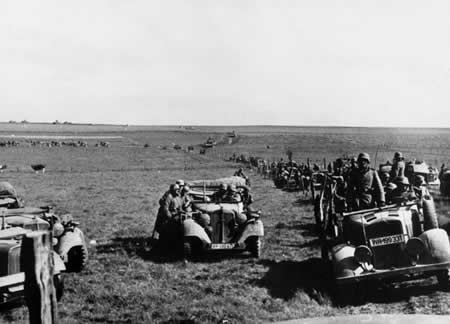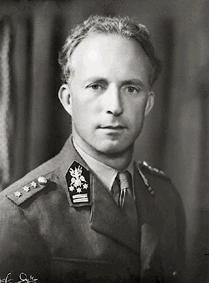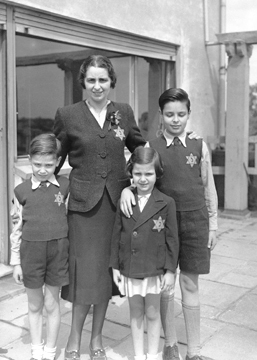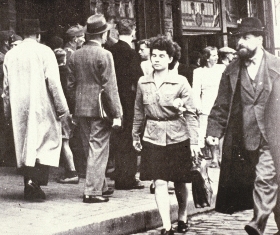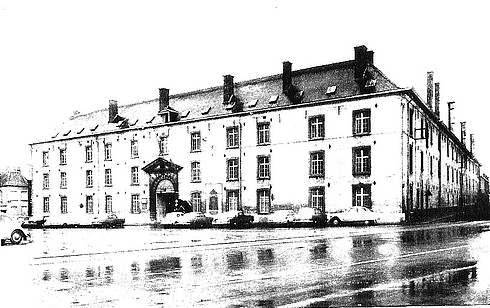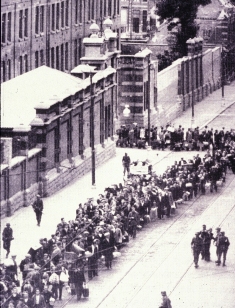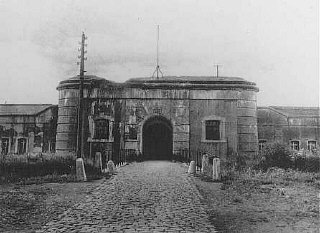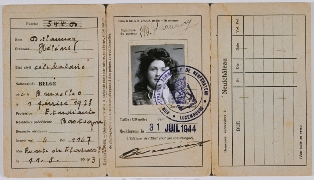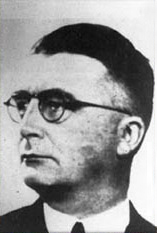Holocaust Education & Archive Research Team |
|
Occupation German Occupation of Europe Timeline
-
[The Occupied Nations]
Poland Austria Belgium Bulgaria Denmark France Germany Greece Hungary Italy Luxembourg The Netherlands Norway Romania Slovakia Soviet Union Sudetenland | |||||
The Destruction of the Jews of Belgium
The Germans invaded Belgium and Holland on the 10 May 1940, as part of the Plan Yellow, and the Western campaign came face to face with Blitzkrieg – Lightning War.
On 28 May 1940 Belgium capitulated to the Germans on the terms of unconditional surrender, King Leopold and Queen Elizabeth decided to remain in Belgium and not escape to England.
There were approximately 85,000 Jews in Belgium just before the war, all but a few of them in the two cities of Antwerp and Brussels. Yet when the Germans on 28 October 1940 forced all Jews to register with the police, the total number registered was only 42,000.
While part of the difference was due to the mass flight across the French border, in the main it must have been reluctance on the Jews part to register. The Nazis were, in fact never able to lay their hands on the well-assimilated, native-born Jewish population, and were indeed reluctant to do so.
The Military Governor General von Falkenhausen, disliked National Socialist extremism and, till his own arrest for complicity in the bomb plot to assassinate Hitler, was able to thwart the designs of the Security Police.
Thus after Helmuth Knochen’s, the Security Police Commander North France and Belgium, conference in Paris on 14 March 1942, von Falkenhausen’s deputy, the Military Administrator in Belgium, Brigadier- General Eggert Reeder, absolutely refused to introduce the Jewish badge, though in the end he yielded to pressure from the Reich Main Security Office (RSHA).
As in other countries, without the support of the administration the Jews faced the usual restrictions such as registration, loss of employment, compulsory labour and the “Aryanisation” of Jewish firms without compensation.
Moreover, even if von Falkenhausen and Reeder pursued a policy intended to placate Belgium public opinion, they never had any scruple about sacrificing the foreign and refugee Jewish population. In fact Belgium was the first of the Western countries occupied by the Germans, from which such Jews were deported.
On 11 June 1942, a discussion took place in the Department for Jewish Affairs of the RSHA. The German experts on the Jewish Affairs stationed in Paris, The Hague and Brussels gathered to discuss the Western European part of the general deportation programme.
Dannecker, the expert for Jewish Affairs of the Gestapo in Paris made a note to himself stating that Himmler had given the order to provide larger quantities of Jews to the Auschwitz concentration camp, to increase the work force.
This is on the primary condition that the Jews (of both sexes) be between 16 and 40 years old. 10% who are not fit for work can be sent with them. According to Dannecker’s note 15,000 Jews were to be deported from the Netherlands, 10,000 from Belgium, and 100,000 from France starting 13 July.
On 5 December 1941 some eighty-three Polish Jewish families were “repatriated” to Poland from Antwerp, while a considerably larger number were sent in February –March 1942 to work in the textile factories of the Litzmannstadt Ghetto.
In the spirit of the Wannsee Conference in January 1942 the SS Obersturnfuhrer Kurt Asche, who was responsible for Jewish affairs in Brussels, received orders on 11 June 1942 to deport 10,000 Jews from Belgium to Auschwitz death camp.
Towards the end of July 1942 the SS opened the former Dossinkazerne in Malines as a Sammellager fur Juden (assembly camp for Jews). The Dossinkazerne Dossin de Saint Georges te Mechelen was an obvious choice for the Nazis.
The barracks were constructed in the 18th century and were located half way between Brussels and Antwerp. In these two cities nearly all of Belgium’s Jews were living. Furthermore next to the barracks was a railway line linking Brussels and Antwerp with a sideline running via Louvain to Germany and beyond.
In addition the proximity of Breendonk, the camp for political and resistance prisoners, gave the Germans the feeling that this area was relatively secure and that the Jewish prisoners would not cause any disturbances amongst the local population. The Dossin Kaserne was therefore the ideal site for the deportations to the east.
The deportation trains which began to run from Malines to Auschwitz on 4 August 1942 were intended for a mass deportation of Jews, both Belgian subjects and non-Belgian – no discrimination was made by Eichmann’s office.
Eichmann’s deportation officers complained to the Foreign Office at the way their instructions were being carried out, consequently on 2 December 1942 Martin Luther and Franz Rademacher initialled a strong protest to Werner von Bargen, the Foreign Office representative with General von Falkenhausen in Brussels, because the native-born Belgian Jews were not being included in the deportations.
By this time thirteen transports had already left Malines but now no Jews reported voluntarily, the deportations now had to be carried out through police raids. Native-born Belgian Jews were first noticed in the Auschwitz death camp after the transport which arrived on 5 August 1942, the total number deported from Malines on this transport numbered 998 people, of which 744 were admitted into the camp.
The one attempt at the mass deportation of Belgian Jews had already proved a failure on 3 September 1943 some hundreds of Antwerp Jews were taken in furniture vans from their homes to the Caserne Dossin in Malines. Soon afterwards, Reeder ordered their release at the instance of Queen Elizabeth and Cardinal Van Roey, and the attempt was not repeated.
It was consequently impossible to find enough stateless and foreign Jews to fill another Auschwitz transport after 20 September 1943, though some 1,800 Jews of various privileged categories were taken in 1944 to Theresienstadt, Bergen-Belsen and other camps.
The transports were governed by the same law of diminishing returns as in France. Five transports left the Caserne Dossin for Auschwitz in August 1942, five in September and three in October.
In 1943 a single transport left for Auschwitz in the months of January, April, July and September. After October 1942 strong young men from the conscript labour camps were included in the Auschwitz death camp transports and escapes became more common. On 15 January 1943 some thirty or forty cut their way out of a train with smuggled saws, two transports from Malines arrive in Auschwitz on 18 January bearing 945 and 610 Jews, out of which 1087 were gassed on arrival.
On 22 April 1943 the Belgian railway-workers contrived to leave some doors open when a transport of 1,586 Jews left the Caserne Dossin, other railwaymen held up the train between Tirlemont and Vise, where the “Comite de defense des Juifs” had organised an ambush. The fire of the SS guards was returned, and 150 Jews were able to escape, though twenty were killed and more than a hundred wounded.
The recaptured Jews, including the wounded, were taken back to Malines and were put on the transport of 31 July 1943, from which, too, thirty nine Jews escaped. This transport, the twenty-first transport from Belgium brings 1553 people, of which 1087 are killed in the gas chambers.
On 15 January 1944 among the Jews deported from Belgium to Auschwitz –Birkenau death camp were the Polish- born Jew Meir Tabakman and his wife Raizl. Tabakman had been deported some months earlier, but had jumped off the train. Later he had been re-captured, now branded as a “flitzer” one who had tried to flee,he was locked in a special goods wagon with many other former escapees. At Birkenau his wife later recalled “not one of them entered the camp.” All went straight to the gas chambers.
At the trial of Falkenhausen and Reeder which was not concluded till 9 March 1951, the Brussels court ruled that both were guilty of ordering the deportation of 25,000 Jews, but they were not responsible for their subsequent extermination in Auschwitz.
Under the Belgian law of remission the generals’ sentences of twelve years imprisonment each were cut to a third and they were released within three weeks.
Falkenhausen and Reeder were in fact imprisoned first then tried later, the scandal of this “Alice in Wonderland” justice does not, however, alter the fact that these two men uprooted the Jews from their homes and confiscated their property, and that they made no meaningful enquiries concerning the ultimate fate of the Jews who passed through their hands.
Sources:
The Final Solution by G. Reitlinger – Vallentine Mitchell &Co Ltd 1953. The Final Solution by G. Reitlinger – Vallentine Mitchell &Co Ltd 1953 . Yad Vashem History of the Second World War, published by Purnell London 1966 Auschwitz Chronicle – by Danuta Czech, published by Henry Holt and Company – New York, 1989. The Holocaust – by Sir Martin Gilbert, published by Collins, London 1986 The Jewish Museum of Deportation and Resistance
Copyright Chris Webb & Carmelo Lisciotto H.E.A.R.T 2008
|
